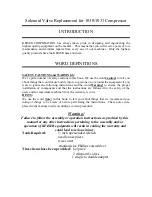
17
Instruction Manual
2.5
A
IR
FLOW
(
SEE
F
IG
. 2.3
)
The system comprises:
AF
Air filter
AR/OS
Air receiver/oil separator
CE
Compressor element
UA/UV
Unloader assembly with unloader valve
BDV
Blow-down valve
FN
Flow nozzle
Air drawn through the airfilter (AF) into the compressor element
(CE) is compressed. At the element outlet, compressed air and oil
pass into the air receiver/oil separator (AR/OS).
The check valve (CV) prevents blow-back of compressed air when
the compressor is stopped. In the air receiver/oil separator (AR/OS),
most of the oil is removed from the air/oil mixture; the remaining oil
is removed by the separator element.
The oil collects in the receiver and on the bottom of the separator
element.
The air leaves the receiver via a flow nozzle (FN) which prevents the
receiver pressure from dropping below the minimum working
pressure (specified in section
8.3
), even when the air outlet valves
are open. This ensures adequate oil injection and prevents oil
consumption.
A temperature switch (TS) and a working pressure gauge (PG) are
comprised in the system.
A blow-down valve (BDV) is fitted in the unloader assembly to
automatically depressurise the air receiver (AR) when the
compressor is stopped.
2.6
O
IL
SYSTEM
(
SEE
F
IG
. 2.3
)
The system comprises:
AR/OS
Air receiver/oil separator
OC
CE
Oil cooler
OF
Oil filter
The lower part of the air receiver (AR) serves as oil tank.
Air pressure forces the oil from the air receiver/oil separator (AR/
OS) through the oil cooler (OC
CE
) and oil filter (OF) to the
compressor element (CE).
The compressor element has an oil gallery in the bottom of its casing.
The oil for rotor lubrication, cooling and sealing is injected through
holes in the gallery.
Lubrication of the bearings is ensured by oil injected into the bearing
housings.
The injected oil, mixed with the compressed air, leaves the
compressor element and re-enters the air receiver, where it is
separated from the air as described in section
2.5
. The oil that
collects in the bottom of the oil separator element is returned to the
system through a scavenging line (SL), which is provided with a
flow restrictor (FR).
The oil filter by-pass valve opens when the pressure drop over the
filter is above normal because of a clogged filter. The oil then by-
passes the filter without being filtered. For this reason, the oil filter
must be replaced at regular intervals (see section
4.2
).
When cold start equipment is installed; a thermostatic valve will
bypass the compressor oil (oil will not pass through oil cooler
OC
CE
), until the working temperature is reached.
2.7
C
ONTINUOUS
REGULATING
SYSTEM
(
SEE
F
IG
. 2.3
)
The system comprises:
RV
Regulating valve
UA
Unloader assembly
SR
Speed regulator
The compressor is provided with a continuous regulating system.
This system is provided with a blow-down valve which is integrated
in the unloader assembly (UA). The valve is closed during operation
by outlet pressure of the compressor element and opens by air
receiver pressure when the compressor is stopped.
When the air consumption increases, the air receiver pressure will
decrease and vice versa. This receiver pressure variation is sensed by
the regulating valve which, by means of control air to the unloader,
matches the air output to the air consumption. The air receiver
pressure is maintained between the pre-selected working pressure
and the corresponding unloading pressure.
When starting the compressor, the unloader valve (UV) is kept open
by spring force, the engine runs at maximum speed. The compressor
element (CE) takes in air and pressure builds up in the receiver (AR).
The air output is controlled from maximum output (100%) to no
output (0%) by:
1. Speed control of the engine between maximum load speed and
unloading speed (the output of a screw compressor is
proportional to the rotating speed).
2. Air inlet throttling.
If the air consumption is equal to or exceeds the maximum air output,
the engine speed is held at maximum load speed and the unloading
valve is fully open.
If the air consumption is less than the maximum air output, the
regulating valve supplies control air to unloader valve (UV) to
reduce the air output and holds air receiver pressure between the
normal working pressure and the corresponding unloading pressure
of approx. 1.5 bar above the normal working pressure.
When the air consumption is resumed, the unloader valve (UV)
gradually opens the air intake and the speed regulator (SR) increases
the engine speed.
The construction of the regulating valve (RV) is such that any
increase (decrease) of the air receiver pressure above the pre-set
valve opening pressure results in a proportional increase (decrease)
of the control pressure to the unloading valve and the speed
regulator.
Part of the control air is vented to the atmosphere, and any
condensate discharged, through the vent holes (VH).
Generator
When the generator is switched on, the solenoid valve (SV
SR
) via the
speed regulator (SR) controls the engine and allows it to reach
maximum speed (the normal control system is switched off).
Содержание XAHS 37 DD
Страница 2: ......
Страница 63: ......
Страница 64: ...Printed in Belgium 07 2007 2954 2140 02 www atlascopco com ...
















































